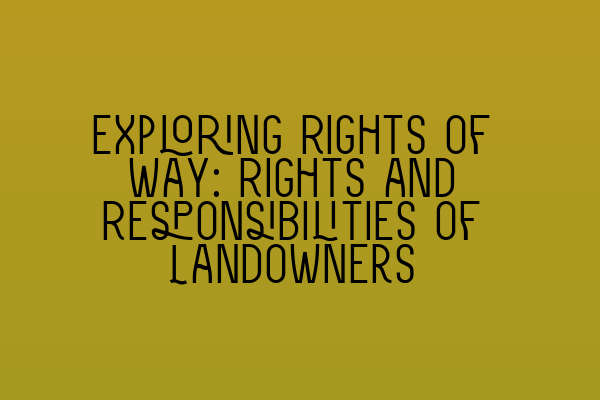Title: Exploring Rights of Way: Rights and Responsibilities of Landowners
Introduction:
Rights of way are legal easements that grant individuals the right to use a particular property or piece of land for a specific purpose. These rights are essential in promoting access and connectivity within communities, but they also come with certain responsibilities for landowners. In this article, we will explore the rights and responsibilities of landowners regarding rights of way.
Understanding Rights of Way:
A right of way is a legal right that allows someone to pass through or use a specific area of land, regardless of whether they own it or not. This right can be granted through various means, such as express grant, prescription, or necessity. It is important to note that rights of way can be limited to certain uses, such as footpaths, bridleways, or vehicular access.
Types of Rights of Way:
There are different types of rights of way that landowners should be aware of:
1. Public Rights of Way: These rights are established for the public to access and enjoy certain areas. They can include footpaths, bridleways, and byways open to all traffic. Landowners have a responsibility to maintain and keep these rights of way accessible to the public.
2. Private Rights of Way: These rights are granted to specific individuals or properties. They can be created through agreements, such as deeds or contracts. Landowners must respect and not obstruct the rights granted to those with private rights of way.
Rights and Responsibilities of Landowners:
Landowners have both rights and responsibilities when it comes to rights of way. It is crucial to understand and fulfill these obligations to maintain harmonious relationships with neighboring properties and uphold legal requirements. Here are the key rights and responsibilities of landowners:
1. Right to Maintain and Repair:
As a landowner, you have the right to maintain and repair the rights of way crossing your property. This includes keeping the path clear of overgrown vegetation, repairing any damages, and ensuring safe passage for users. Regular inspections and prompt maintenance can help prevent issues and ensure compliance with legal obligations.
2. Limitations on Use:
While landowners have the right to control access to their property, they must not unreasonably obstruct or interfere with the rights of way granted. Erecting gates, fences, or other barriers without proper justification can lead to legal disputes. It is advisable to consult with a legal professional to understand the extent of your limitations on use.
3. Responsibility for Safety:
Landowners have a responsibility to ensure the safety of individuals using the rights of way on their property. This includes addressing potential hazards, such as potholes, loose paving, or uneven terrain. Regular assessments and timely repairs are essential to minimize risks and fulfill this duty of care.
4. Preserving the Right of Way:
Landowners should strive to preserve the existence and integrity of the rights of way on their property. This means not obstructing or obstructing access to the right of way, as it can lead to claims for extinguishment or relocation. Open communication with users and neighboring landowners can help resolve any potential conflicts or misunderstandings.
Conclusion:
Rights of way play a crucial role in maintaining community connectivity and providing access to various properties. As a landowner, understanding your rights and responsibilities regarding rights of way is essential to avoid legal disputes and foster positive relationships with neighboring properties. By fulfilling your obligations to maintain, respect, and ensure the safety of rights of way, you contribute to the overall well-being of your community and preserve the fundamental principles of property law.
Related Articles:
– SQE 1 Practice Exam Questions
– SQE 1 Practice Mocks FLK1 FLK2
– SQE 2 Preparation Courses
– SQE 1 Preparation Courses
– SRA SQE Exam Dates
